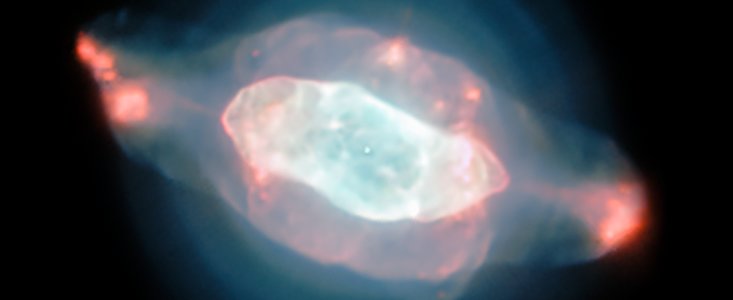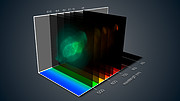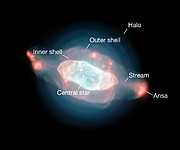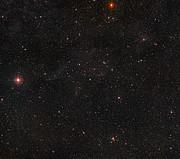Persbericht
De vreemde structuren van de Saturnusnevel
27 september 2017
De spectaculaire planetaire nevel NGC 7009, oftewel de Saturnusnevel, doemt op uit de duisternis als een verzameling vreemd gevormde bellen in magnifieke tinten roze en blauw. Deze kleurrijke opname is vastgelegd met het krachtige MUSE-instrument van ESO’s Very Large Telescope (VLT). Dat gebeurde in het kader van een onderzoek waarbij voor het eerst het stof binnen een planetaire nevel in kaart is gebracht. Deze kaart – die een overvloed aan complexe structuren in het stof openbaart, waaronder schillen, een halo en een merkwaardige golfachtige structuur – leert astronomen begrijpen hoe planetaire nevels aan hun vreemde vormen en symmetrieën komen.
De Saturnusnevel bevindt zich op een afstand van ongeveer 5000 lichtjaar in het sterrenbeeld Aquarius (Waterman). Zijn benaming heeft hij te danken aan zijn vreemde vorm, die overeenkomsten vertoont met de bekende planeet met de ringen.
In werkelijkheid hebben planetaire nevels niets met planeten te maken. De Saturnusnevel was oorspronkelijk een lichte ster die aan het einde van zijn bestaan uitdijde tot een rode reus en zijn buitenlagen begon af te stoten. Dit materiaal is weggeblazen door krachtige sterrenwinden, en door de ultraviolette straling van de achtergebleven hete sterkern tot lichten gebracht. Het resultaat is een circumstellaire nevel van stof en kleurrijk heet gas. In het hart van de Saturnusnevel staat een ten dode opgeschreven ster (ook te zien op deze foto), die bezig is om in een witte dwerg te veranderen [1].
Om beter te kunnen begrijpen hoe planetaire nevels aan zulke vreemde vormen komen, heeft een internationaal team onder leiding van Jeremy Walsh van ESO de stofsluiers van de Saturnusnevel onder de loep genomen met de Multi Unit Spectroscopic Explorer (MUSE), een instrument dat aan een van de vier Unit Telescopes van de Very Large Telescope van de ESO-sterrenwacht op de Paranal (Chili) is gekoppeld. Dit veelzijdige instrument maakt niet alleen een opname, maar verzamelt voor elk punt van de opname ook informatie over het spectrum – de samenstellende kleuren – van het licht van het object.
Het team heeft MUSE ingezet om de eerste detailrijke optische kaarten te maken van het gas en stof in deze planetaire nevel [2]. De resulterende opname van de Saturnusnevel toont tal van complexe structuren, waaronder een ellipsvormige binnenschil, een buitenschil en een halo. Ook laat hij twee al eerder vastgelegde straalstromen zien die zich over de volle lengte langs de lengteas van de nevel uitstrekken. Deze stromen eindigen in heldere ansae (Latijn voor ‘handvaten’).
Het team ontdekte ook een golfachtige structuur in het stof, die nog niet volledig begrepen wordt. Verspreid over de hele nevel is stof te zien, maar aan de rand van de binnenschil vertoont de hoeveelheid stof een significante afname. Het lijkt erop dat het stof daar wordt vernietigd, wat op verschillende manieren kan gebeuren. De binnenschil is in werkelijkheid een uitdijende schokgolf die de stofdeeltjes wel eens zou kunnen vergruizen. Een andere mogelijkheid is dat de schokgolf met zoveel warmteontwikkeling gepaard gaat dat het stof verdampt.
Het in kaart brengen van de gas- en stofstructuren binnen planetaire nevels geeft meer inzicht in de evolutie en dood van lichte sterren, en leert astronomen begrijpen hoe deze nevels aan hun vreemde, complexe vormen komen.
De mogelijkheden van MUSE beperken zich overigens niet tot het onderzoek van planetaire nevels. Dit gevoelige instrument kan ook de vorming van sterren en sterrenstelsels in het vroege heelal onderzoeken en de verdeling van de donkere materie in nabije clusters van sterrenstelsels in kaart brengen. Ook heeft MUSE de eerste driedimensionale kaart gemaakt van de Zuilen der schepping in de Adelaarnevel (eso1518) en een spectaculaire kosmische botsing in een nabij sterrenstelsel in kaart gebracht (eso1437).
Noten
[1] Planetaire nevels bestaan doorgaans maar kort. Over slechts enkele tienduizenden jaren zal de Saturnusnevel zodanig zijn uitgedijd en afgekoeld dat hij onzichtbaar is geworden. De centrale ster zal in een hete witte dwerg veranderen en geleidelijk uitdoven.
[2] De Hubble-ruimtetelescoop van NASA en ESA heeft eerder al een spectaculaire opname van de Saturnusnevel gemaakt, maar – anders dan MUSE – heeft hij daarbij niet het spectrum voor elk punt van de nevel vastgelegd.
Meer informatie
ESO is de belangrijkste intergouvernementele astronomische organisatie in Europa en verreweg de meest productieve sterrenwacht ter wereld. Zij wordt ondersteund door zestien lidstaten: België, Brazilië, Denemarken, Duitsland, Finland, Frankrijk, Italië, Nederland, Oostenrijk, Polen, Portugal, Spanje, Tsjechië, het Verenigd Koninkrijk, Zweden en Zwitserland, en door gastland Chili. ESO voert een ambitieus programma uit, gericht op het ontwerpen, bouwen en beheren van grote sterrenwachten die astronomen in staat stellen om belangrijke wetenschappelijke ontdekkingen te doen. Ook speelt ESO een leidende rol bij het bevorderen en organiseren van samenwerking op astronomisch gebied. ESO beheert drie waarnemingslocaties van wereldklasse in Chili: La Silla, Paranal en Chajnantor. Op Paranal staan ESO’s Very Large Telescope (VLT), de meest geavanceerde optische sterrenwacht ter wereld, en twee surveytelescopen. VISTA werkt in het infrarood en is de grootste surveytelescoop ter wereld en de VLT Survey Telescope is de grootste telescoop die specifiek is ontworpen om de hemel in zichtbaar licht in kaart te brengen. ESO speelt ook een belangrijke partnerrol bij ALMA, het grootste astronomische project van dit moment. En op Cerro Armazones, nabij Paranal, bouwt ESO de 39-meter Extremely Large Telescope, de ELT, die ‘het grootste oog op de hemel’ ter wereld zal worden.
Links
- Foto’s van de VLT
- Foto’s van MUSE
- Persbericht over het ‘eerste licht’ van MUSE
Contact
Jeremy Walsh
ESO
Garching bei München, Germany
E-mail: jwalsh@eso.org
Richard Hook
ESO Public Information Officer
Garching bei München, Germany
Tel: +49 89 3200 6655
Mobiel: +49 151 1537 3591
E-mail: rhook@eso.org
Marieke Baan (Perscontact Nederland)
ESO Science Outreach Network
en NOVA Informatie Centrum
Tel: +31(0)20-5257480
E-mail: eson-netherlands@eso.org
Over dit bericht
| Persberichten nr.: | eso1731nl |
| Naam: | NGC 7009, Saturn Nebula |
| Type: | Milky Way : Nebula : Type : Planetary |
| Facility: | Very Large Telescope |
| Instruments: | MUSE |
Our use of Cookies
We use cookies that are essential for accessing our websites and using our services. We also use cookies to analyse, measure and improve our websites’ performance, to enable content sharing via social media and to display media content hosted on third-party platforms.
ESO Cookies Policy
The European Organisation for Astronomical Research in the Southern Hemisphere (ESO) is the pre-eminent intergovernmental science and technology organisation in astronomy. It carries out an ambitious programme focused on the design, construction and operation of powerful ground-based observing facilities for astronomy.
This Cookies Policy is intended to provide clarity by outlining the cookies used on the ESO public websites, their functions, the options you have for controlling them, and the ways you can contact us for additional details.
What are cookies?
Cookies are small pieces of data stored on your device by websites you visit. They serve various purposes, such as remembering login credentials and preferences and enhance your browsing experience.
Categories of cookies we use
Essential cookies (always active): These cookies are strictly necessary for the proper functioning of our website. Without these cookies, the website cannot operate correctly, and certain services, such as logging in or accessing secure areas, may not be available; because they are essential for the website’s operation, they cannot be disabled.
Functional Cookies: These cookies enhance your browsing experience by enabling additional features and personalization, such as remembering your preferences and settings. While not strictly necessary for the website to function, they improve usability and convenience; these cookies are only placed if you provide your consent.
Analytics cookies: These cookies collect information about how visitors interact with our website, such as which pages are visited most often and how users navigate the site. This data helps us improve website performance, optimize content, and enhance the user experience; these cookies are only placed if you provide your consent. We use the following analytics cookies.
Matomo Cookies:
This website uses Matomo (formerly Piwik), an open source software which enables the statistical analysis of website visits. Matomo uses cookies (text files) which are saved on your computer and which allow us to analyze how you use our website. The website user information generated by the cookies will only be saved on the servers of our IT Department. We use this information to analyze www.eso.org visits and to prepare reports on website activities. These data will not be disclosed to third parties.
On behalf of ESO, Matomo will use this information for the purpose of evaluating your use of the website, compiling reports on website activity and providing other services relating to website activity and internet usage.
Matomo cookies settings:
Additional Third-party cookies on ESO websites: some of our pages display content from external providers, e.g. YouTube.
Such third-party services are outside of ESO control and may, at any time, change their terms of service, use of cookies, etc.
YouTube: Some videos on the ESO website are embedded from ESO’s official YouTube channel. We have enabled YouTube’s privacy-enhanced mode, meaning that no cookies are set unless the user actively clicks on the video to play it. Additionally, in this mode, YouTube does not store any personally identifiable cookie data for embedded video playbacks. For more details, please refer to YouTube’s embedding videos information page.
Cookies can also be classified based on the following elements.
Regarding the domain, there are:
- First-party cookies, set by the website you are currently visiting. They are stored by the same domain that you are browsing and are used to enhance your experience on that site;
- Third-party cookies, set by a domain other than the one you are currently visiting.
As for their duration, cookies can be:
- Browser-session cookies, which are deleted when the user closes the browser;
- Stored cookies, which stay on the user's device for a predetermined period of time.
How to manage cookies
Cookie settings: You can modify your cookie choices for the ESO webpages at any time by clicking on the link Cookie settings at the bottom of any page.
In your browser: If you wish to delete cookies or instruct your browser to delete or block cookies by default, please visit the help pages of your browser:
Please be aware that if you delete or decline cookies, certain functionalities of our website may be not be available and your browsing experience may be affected.
You can set most browsers to prevent any cookies being placed on your device, but you may then have to manually adjust some preferences every time you visit a site/page. And some services and functionalities may not work properly at all (e.g. profile logging-in, shop check out).
Updates to the ESO Cookies Policy
The ESO Cookies Policy may be subject to future updates, which will be made available on this page.
Additional information
For any queries related to cookies, please contact: pdprATesoDOTorg.
As ESO public webpages are managed by our Department of Communication, your questions will be dealt with the support of the said Department.








